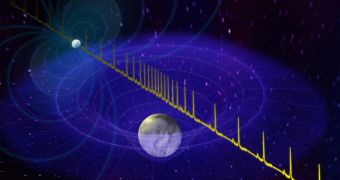A group of investigators believes it may have stumbled upon the most massive neutron stars ever discovered. The new body is about twice as heavy as the Sun, a fact that lends additional credence to theories saying that they are made up mostly of neutrons.
Some theories have stated that the bodies could also be made of other exotic particles. However, astronomers say that this is most likely not the case.
Neutron stars form from the collapsed cores of massive stars that reach the end of their burning cycle. When they exhaust their hydrogen fuel reserves, the stars blow up, and their cores implode to form either a black hole or a neutron star.
In the latter case, the resulting bulb of crushed, ultra-dense matter spins very fast. Due to the extremely violent nature of the supernova explosions that create these objects, the protons and neutrons inside the former star are crushed together to form neutrons.
One thing about this peculiar class of objects is that its components are usually no more than 12 miles (19.3 kilometers) in diameter. Still, they pack the mass of the Sun in that small volume.
This is why the discovery of the new object, called PSR J1614-2230 is so amazing. The body, which is located about 3,000 light-years away from our planet, is twice as heavy as the Sun, and therefore much more massive than any known neutron star in the Universe.
In fact, investigators from the National Radio Astronomy Observatory (NRAO) say that the object is some 20 percent more massive than the next large neutron star. It has a weight of 1.67 solar masses.
“We didn't really know for sure that neutron stars could get quite this massive until we made this measurement – it was very surprising and exciting,” says astronomer Paul Demorest.
“The typical thinking was that most neutron stars clustered pretty tightly around 1.4 solar masses,” the NRAO researcher tells Space.
He adds that the new investigations could be used to gain additional insight into how gamma-ray bursts (GRB) form. These are the most violent phenomena known to happen in the Universe.
In the past, researchers have argued that short-duration GRB, a subtype of the blasts, are generated by neutron stars when they slam into each other. But the maximum size of neutron stars known at the time did not allow for the formation of intense GRB.
If other bodies such as PSR J1614-2230 exist, then collisions between these objects could account for some of the most intense GRB, the NRAO research team says.
“Pulsars in general give us a great opportunity to study exotic physics, and this system is a fantastic laboratory sitting out there, giving us valuable information with wide-ranging implications,” explains Ransom.
“It is amazing to me that one simple number – the mass of this neutron star – can tell us so much about so many different aspects of physics and astronomy,” he goes on to say.
The research was recently published, in the October 28 issue of the esteemed scientific journal Nature, and it will also be detailed in an upcoming issue of the Astrophysical Journal Letters.

 14 DAY TRIAL //
14 DAY TRIAL //